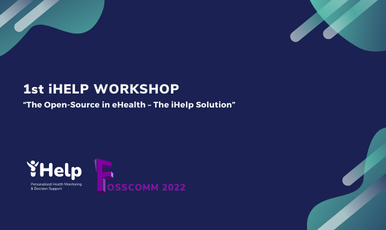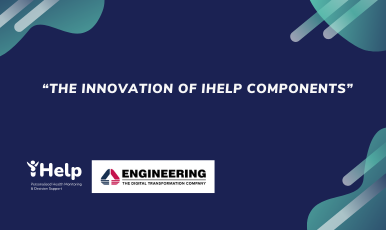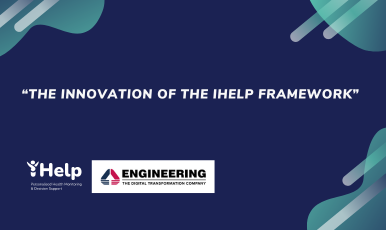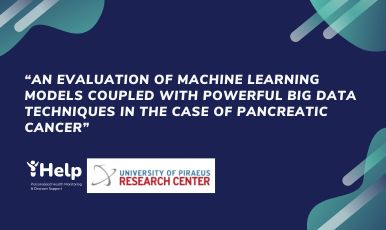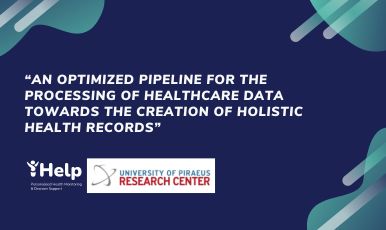Since the project has moved to its third and final year it is time to have a small recap of the project’s activities and accomplishments during the previous year. In that sense, one of the previous year’s highlights of the iHelp project was its participation in FOSSCOMM 2022 in Lamia, Greece, which is an annual national conference of free and open-source software communities, created for developers, students, and anyone interested in open-source technologies. In the context of this conference, the iHelp project organized a workshop entitled “Open-Source in eHealth – The iHelp Solution” (see Fig.1) where the gains, the obstacles, and the requirements of the utilization of open-source solutions in the eHealth domain were first presented and detailed. Afterward, the presentation of the iHelp project was followed, as well as the open-source technologies and tools that have been designed and implemented in its context to facilitate and enhance the processing and analysis of primary and secondary health data with regard to the utilization of solutions towards the prediction and assessment of risk developing Pancreatic Cancer.
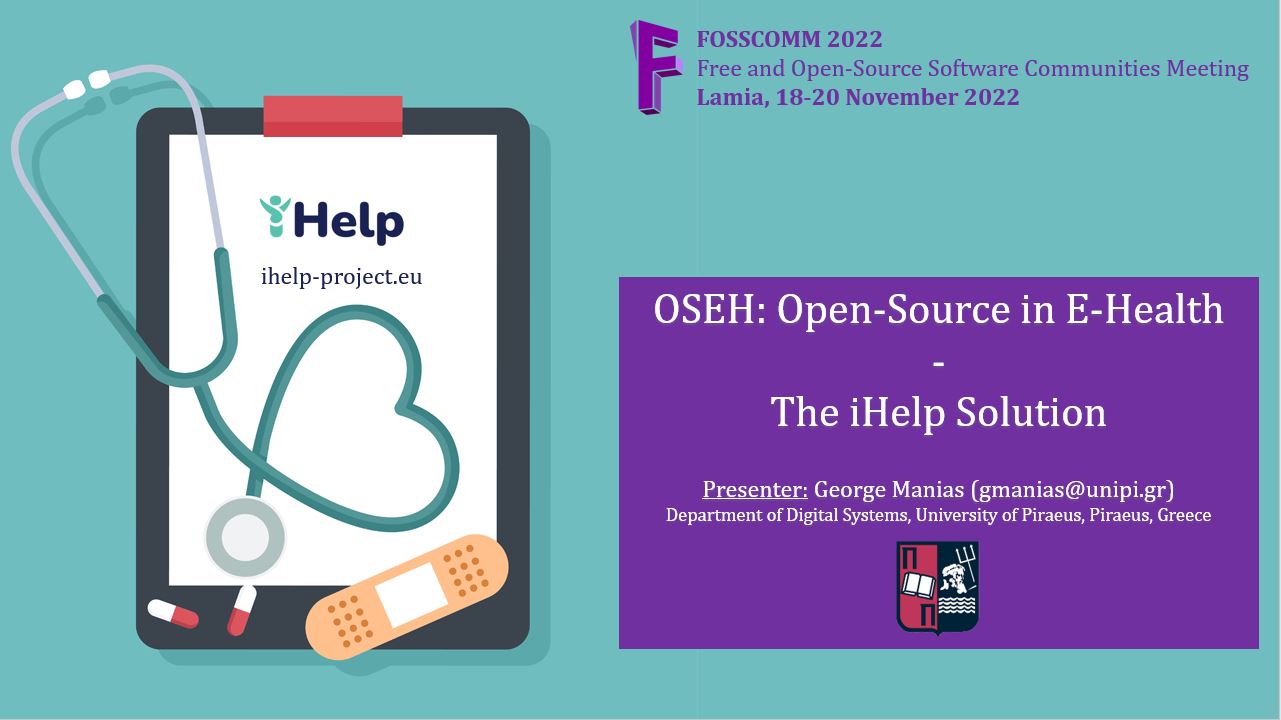
To better understand the crucial role that open-source tools can have in the eHealth domain, at first it was noted that the successful exploration and interpretation of all the health-related data plays a vital role in the modern healthcare domain [1]. Healthcare data are available in different forms (e.g., images, signals, and wavelengths, etc.). All these data may come from different healthcare entities, i.e., patients themselves, healthcare professionals (HCPs), etc., where more and more entities place data demands on other entities, and many healthcare organizations find themselves overwhelmed with data, but lacking truly valuable information. At the same time, the use of electronic health records (EHRs) enables the management of patient data, for health care as well as other purposes, across any kind of institutional, regional, or national border. EHRs represent a resilient health system with patients at their center and provide real-time, patient-centered records that make information available instantly and securely to authorized users. Data can thus be shared and used more effectively for quality assurance, disease surveillance, public health monitoring, and research. Nonetheless, what is required refers to the standardization of data models to support interoperability between all the medical information systems that stored clinical information about patients. Due to the improvement in the automatic collection of data from medical devices and systems, researchers and analysts can monitor data or information that can be accessed in electronic configuration [2]. On top of that, a crucial role in the huge expansion of healthcare data plays wearable devices.
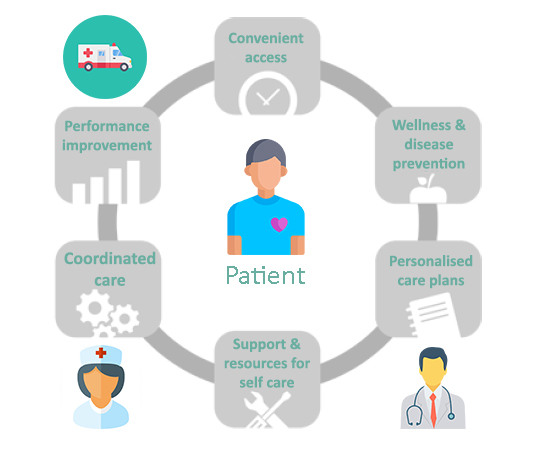
To address these challenges, many open-source analytics frameworks have developed large open ecosystems, with many contributing organizations, which is essential for achieving a federated analytics framework that can handle a broad and growing set of heterogeneous data sources [3]. Open-source software is a promising way for healthcare organizations to reduce costs while remaining flexible enough to adopt new, innovative and emerging solutions that will enable future improvements in patient care and business operations [4]. To this end, open source encourages collaboration among different stakeholders of the healthcare domain to build ever-changing and improving infrastructure technology [5]. This collaborative strategy has the potential to bring technology innovations into the healthcare domain much more quickly than independent development. Healthcare organizations need to understand what open source is and how it is significant to enhance and foster health innovations that will save money and help clinicians treat, monitor and advice patients in more efficient ways. As depicted in Fig.2 the adoption and utilization of open-source solutions will facilitate the implementation of patient-centric healthcare applications that will help HCPs (i) to access useful information and tools to identify, diagnose, and treat their patients, (ii) to provide personalised care plans and recommentations, (iii) to develop personalised prevention and intervention measures, and (iv) to improve care coordination among the different stakehodlers and HCPs included in patient care plan.

The iHelp project introduces a novel personalised-healthcare platform with integrated open-source tools that serve the needs of different stakeholders in the healthcare domain and facilitates the access to evidence-based tools that HCPs can use to make decisions about a patient’s care plan with regards to the Pancreatic Cancer. In that context, the iHelp delivers open-source tools that enable the collection, integration and management of health-related data from various sources (medical records, lifestyle behaviours, social media interactions, etc.) in a standardised structure, the HHRs. On top of this, it provides also a set of innovative multi-level and open-source decision support mechanisms to facilitate the building of personalized risk detection, prevention and intervention models. To address these key challenges and objectives the open-source tools that are implemented and utilized in the iHelp platform are detailed below and further highlighted in Fig.4 that depicts the overall iHelp architecture and the exact placement of these open-source tools in it and across the different layers.
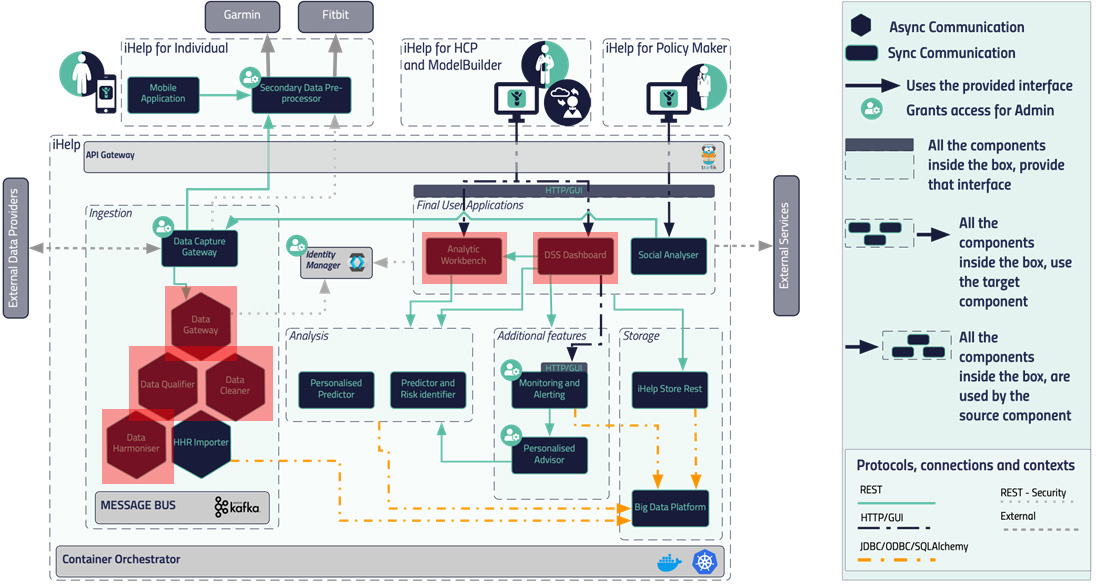
More specifically, as depicted in Fig.4 several different open-source tools either from the Ingestion layer or the Final User Applications layer of the iHelp platform have been designed and implemented. As concerns the Ingestion layer the Data Gateways and the Standardization and Qualification Mechanism, which further incorporates the Data Cleaner, the Data Qualifier, and the Data Harmonizer, are the representative open-source tools. While, with regards to the Final User Applications layer the Analytic Workbench and the DSS Dashboard, which further incorporates the Explainable Dashboard Hub (EDH), are the two open-source components that have been designed and implemented to provide user-engagement toolsets and personalized interfaces for early risk identification, prevention, and intervention mechanisms. All the above were further presented and detailed in the context of the FOSSCOMM2022 conference and a video demonstration was also presented to the audience to better understand and identify how the key prerequisites of a successful open-source platform are addressed through the implementation and utilization of the different open-source tools within the iHelp project.
Through these open-source approaches and components, the iHelp project is finally in place to introduce an integrated environment for addressing the challenge of providing multi-dimensional analytic views on integrated data and extracting value for different stakeholders in the eHealth domain.
References
[1] Jayaraman, P. P., et al., (2020). Healthcare 4.0: A review of frontiers in digital health. Wiley Interdisciplinary Reviews: Data Mining and Knowledge Discovery, 10(2), e1350.
[2] Pandey, S. C. (2016). Data mining techniques for medical data: a review. In 2016 International Conference on Signal Processing, Communication, Power and Embedded System, pp. 972-982.
[3] Brandão, A., Pereira, E., Esteves, M., Portela, F., Santos, M. F., Abelha, A., & Machado, J. (2016). A benchmarking analysis of open-source business intelligence tools in healthcare environments. Information, 7(4), 57.
[4] Aminpour, F., Sadoughi, F., & Ahmadi, M. (2013). Towards the application of open source software in developing national electronic health record-narrative review article. Iranian Journal of Public Health, 42(12), 1333.
[5] Richterich, A. (2020). When open source design is vital: critical making of DIY healthcare equipment during the COVID-19 pandemic. Health Sociology Review, 29(2), 158-167.

